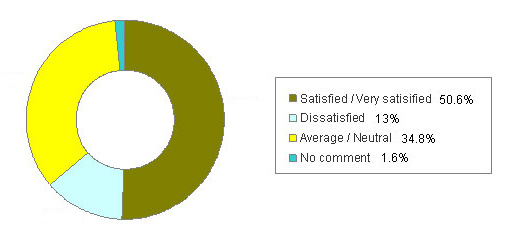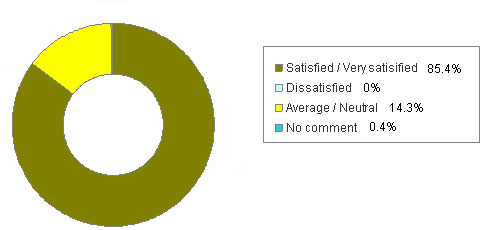| Financial Performance | Domestic Rent Policy | Resource Optimisation | |||||
| Operating with Cost Effectiveness | Case Study: Total Maintenance Scheme | ||||||
This year, the Housing Authority (HA) has taken another major step forward in achieving a sustainable future. This is particularly highlighted by the introduction of a new domestic rent adjustment mechanism, which provides a more flexible framework that better reflects Public Rental Housing (PRH) tenants' affordability and contributes to the long-term sustainability of the public housing programme. We also aim to ensure more rational and efficient use of public housing resources.
| Economic Performance Targets for period 2006/07 | Performance |
| Complete the review of the Domestic Rent Policy and consult the public of the initial findings. | Fully met. |
| Continue to minimize the vacancy of PRH estates. | Fully met. |
| Conduct tenancy control and education campaigns with an aim to recover more flats and reduce abuse of housing resources. | Fully met. |
| Continue on assessment of older estates and enhance their preventative maintenance restoration and improvements. | Fully met. |
Supporting the vision and mission of the Housing Authority (HA), the delivery of quality financial management through a 'best practice' approach remained our key focus in 2006/07. We continued to explore opportunities to improve and strengthen our financial and risk-management processes in order to provide maximum financial and business value in all our activities.
The HA is financially autonomous and its massive public housing programmes are sustained through internally generated funds.
The overall consolidated surplus for the HA for 2006/07 was HK$3.942 billion. The total capital expenditure for 2006/07 was HK$3.852 billion which was slightly higher than 2005/06 by about 2%.
As of 31 March 2007, the HA's funds available for investment stood at HK$52.455 billion.
Domestic Rent Policy
The mission of the Housing Authority (HA) is to provide public rental housing to needy families who cannot afford private rental accommodation. It has been the HA's long-standing policy to keep the rent of Public Rental Housing (PRH) affordable.
A New Rent Adjustment Mechanism
In June 2006, a three-month public consultation on the review of Domestic Rent Policy ended. The review had been carried out by the HA's Ad Hoc Committee with a view to mapping out a rent policy that is more flexible, matching more closely tenants' affordability, and promotes the long-term sustainability of Hong Kong's public housing programme.
Taking full account of the public views received during the consultation, the HA endorsed the report on the Review of Domestic Rent Policy in November 2006. Amongst other important recommendations is a new PRH rent adjustment mechanism that provides for both upward and downward PRH rent adjustments based on changes in household income of PRH tenants. To enable its proper operation, in January 2007, the Government introduced the Housing (Amendment) Bill 2007 into the Legislative Council to replace the statutory 10% median rent-to-income ratio in the Housing Ordinance (Cap. 283) with the new income-based rent adjustment mechanism. The Housing (Amendment) Ordinance 2007 was passed by the Legislative Council in June 2007 and had come into operation on 1 January 2008. To provide a new starting point for the income-based rent adjustment mechanism to operate effectively, the HA reduced the PRH rent by 11.6% starting from August 2007.![]()
Rent Remission
In February 2007 the HA decided to grant a one-month-off rent remission for their PRH tenants and interim housing licensees. The rent remission resulted in a loss of revenue of
HK$963 million for the HA.
In July 2006, to improve the vacancy rate at wet markets, we introduced extra rent free concessions for shop stalls that have remained vacant after at least three open tender exercises. The extra rent free periods range from two to six months, depending on the duration of vacancy. To ensure that this offer will not be misused, the rent-free period is granted in stages throughout the three-year tenancy. In view of the positive market response, this extra rent-free initiative was extended in March 2007 to long-standing vacant retail shops.
Rent Assistance Scheme
The Rent Assistance Scheme was first introduced in 1992 aiming at granting relief in the form of rent reduction to PRH tenants who are facing temporary financial hardship. Its eligibility criteria have been reviewed and relaxed on several previous occasions. In August 2007, the criteria were further relaxed so that assistance would be more readily available to needy tenants. The rent-to-income ratio (RIR) and household income threshold were lowered respectively from a RIR of 20% to 18.5% and income threshold from 60% to 70% of the respective Waiting List Income Limits. The resident requirement for newer PRH block types was reduced from three to two years, and the requirement of moving to cheaper PRH accommodation after receiving rent assistance for three consecutive years was relaxed and better defined. Elderly households and those living in older block types (except for under-occupation cases) are exempted from this requirement of moving to cheaper accommodation. At the end of March 2007, some 39 000 households had benefited from this scheme.![]()
Sale of Surplus Home Ownership Scheme Flats
The repositioning of Hong Kong's housing policies in 2002 saw the cessation of the Housing Authority (HA)'s subsidised home ownership schemes including the production and the sale of flats under the Home Ownership Scheme (HOS), the Private Sector Participation Scheme and the Tenants Purchase Scheme. To address the surplus of some 16 600 HOS flats, we rolled out a detailed programme for the sale of these units in April 2006. Some 16 600 surplus HOS flats were to be offered for sale in phases over the 2007 to 2009 period. In January 2007, the first phase took place when 3 056 surplus HOS flats were placed for sale to eligible applicants. The flats were located at Kingsford Terrace Stage I in Wong Tai Sin, Yu Chui Court Stage III in Sha Tin and Block J of Tin Fu Court in Tin Shui Wai. The average selling price was set at a 30 per cent discount of the assessed market values. The exercise went well with more than 99% of the flats being sold. We carried out pre-sale maintenance and rectification work to ensure that the flats could be handed over to purchasers in a reasonable condition.
Reinstatement for Elderly Tenants
In November 2006, the Subsidised Housing Committee approved the issuance of a Letter of Assurance or a Letter of Reinstatement on request to the elderly tenants whose Public Rental Housing (PRH) tenancies have been surrendered or tenancies deleted upon their admission to residential care homes for the elderly. This is to guarantee their return to PRH should the need arise in the future.
Shortening the Letting Process for Commercial Premises
During 2006/07, considerable effort was expended to shorten the letting process for commercial premises and minimise the vacancy period between lettings of these premises. To this end, Open Instant Tenders (OIT) and Walk-in Applications were introduced to provide more flexible rental terms with the first OIT being held in October 2006. ![]()
Promotion to Enhance Car Park Occupancy
To enhance PRH and car park usage rates, starting from 1 June 2006, HA car parks charges have been reduced by 8.3% for hourly charges in urban and extended areas, and by 12.5% in New Territories. In addition, since April 2006 monthly charges for private cars in some 30 car parks with occupancy rates below 50% have also been reduced by an average of 6%.
In addition, since January 2007, the minimum purchasing requirement from 100 parking coupons and its multiples has been halved to 50 parking coupons and its multiples. A 20% discount on car parking coupons was offered to make it easier for smaller shop tenants to benefit from bulk purchase.
Prompted by the Link Management's car parking increases of around 7% in their high occupancy car parks, the decision was taken to apply full monthly charges at our car parks enjoying occupancy rates of 90% and above. At the same time, the current reduced day pass rate was also extended to cover weekends and public holidays as well. ![]()
Operating with Cost-Effectiveness
Enhancing Occupancy Rate
To enhance occupancy rates to Public Rental Housing (PRH), the Accelerated Refurbishment On-Demand Scheme has been endorsed. In 2006/07, this Scheme reduced the average letting cycle from 57 to 34 days. PRH tenants choosing the refurbishment allowance now receive their flats within two weeks.
Comprehensive Structural Investigation Programme
To ensure the quality of existing estates, a Comprehensive Structural Investigation Programme (CSIP) was launched in 2005 to look into the structural safety and economic sustainability of our estates that are over or about 40 years old. By 2006/07, six studies had been completed and concluded that apart from So Uk Estate, which will be redeveloped in two phases from 2008/09 to 2011/12, these estates will be retained for a further period of 15 years. Estate Improvement Programmes are in place to implement any necessary repair works and other ongoing improvements include the installation of additional lifts, the provision of better leisure facilities and the launching of landscaping activities.
Project Performance Improvement Through the Use of Expertise
To integrate our expertise with those of our contractors, in June 2006 we introduced the Modified Guaranteed Maximum Price Contracting Model on a pilot basis. The Model allows the contractor to commit to a price ceiling, based on his design proposals at the start of the project. Under this Model, any cost savings made from the project are shared equally between the contractor and the Housing Authority. The Model has been applied to Eastern Harbour Crossing Phase 4 in Yau Tong on a trial basis and has resulted in savings of HK$350 000.![]()
Improvements in Construction Quality
Improved construction quality translates into greater sustainability of our estates, lower future maintenance costs and a pleasant and more sustainable living environment for our residents. We therefore continued to make the best use of new construction techniques, suitable building materials, effective tender practices as well as timely contract management and associated monitoring initiatives. We are particularly pleased to report that the construction costs for our superstructure works were 40% lower than projects of similar scope in the private sector. This has further forwarded our aim in producing and providing affordable homes for those in need.
Maintaining Quality Housing
To ensure the continuing quality and cost-effectiveness of housing and estate facilities for our tenants, we provide regular maintenance to PRH through a series of programmes, including the Total Maintenance Scheme, the CSIP and the Independent Checking of the regulatory requirements of development proposals and Performance Monitoring of our service providers.
The Housing Department's Public Housing Recurrent Survey 2006 showed that the satisfaction levels of PRH households towards their estate management services reached their highest levels ever.
Independent Checking and Performance Monitoring
To ensure the regulatory compliance of PRH facilities, the Independent Checking Unit continues to provide third party monitoring and building control of all new HA developments and alteration and addition works to the existing stock of Housing Authority buildings. During the 2006/07, the unit also processed advice to the Licensing Authorities and regulated the use of all lift and escalator installations within our estates in line with the relevant requirements of the Lifts and Escalators (Safety) Ordinance.
![]()
Case Study: Total Maintenance Scheme (TMS)
We introduced our Total Maintenance Scheme (TMS) in 2006 as an innovative and proactive approach to the maintenance of our public rental housing stock. The scheme aims to check both the external and internal condition of flats in 30 estates annually, with a view to completing the inspection of all Public Rental Housing developments in a continuing five-year cycle.
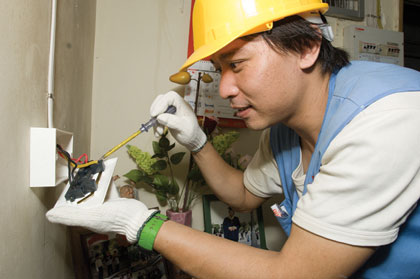 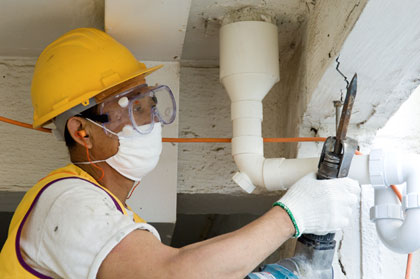 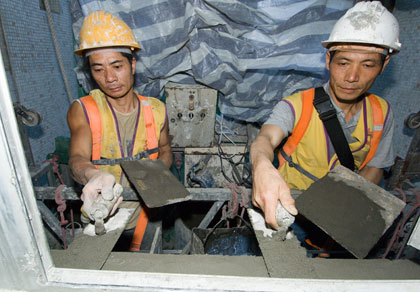 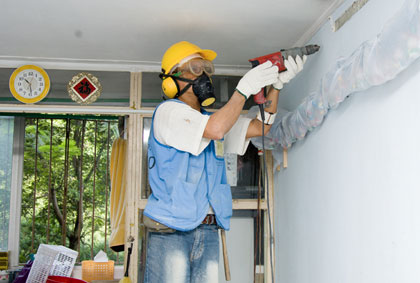 |
The programme works hand-in-hand with our tenants to identify defects not only in the common areas but also in their homes. We encourage our tenants to bring these defects to our attention before they develop into more serious and thus costlier problems.
Our "In-Flat Inspection Ambassadors" carry out inspections and arrange minor touch-up work, as necessary, on the spot. Work orders are also issued straight away for serious repairs, to ensure that they are fixed in a speedy fashion. Since the launch of the TMS, our ambassadors have commenced visits, inspections and repairs in 26 estates. By the end of March 2007, they had visited 34 400 homes and issued over 26 600 repair orders.
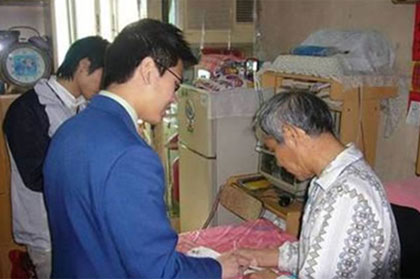 |
The TMS has also brought a number of new initiatives into existence, including the setting up of a flat-to-flat maintenance database as well as the strengthening of research in building diagnostic methodologies and maintenance technologies.
The TMS works in tandem with our Comprehensive Structural Investment Programme, which is being carried out on our older housing estates. These two programmes, supported by our Estate Improvement Programmes, ensure the sustainability of public housing stock as they check the safety, building quality, quality of accommodation, as well as the lifestyle and living standards in our housing developments.
Customer Satisfaction Survey: Pre-Total Maintenance Scheme
